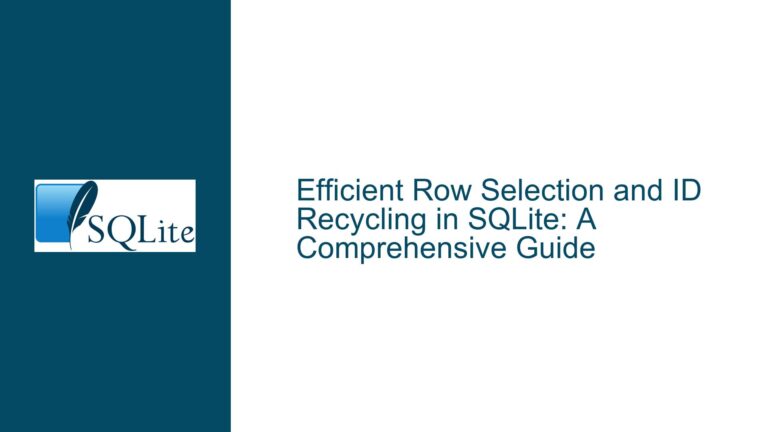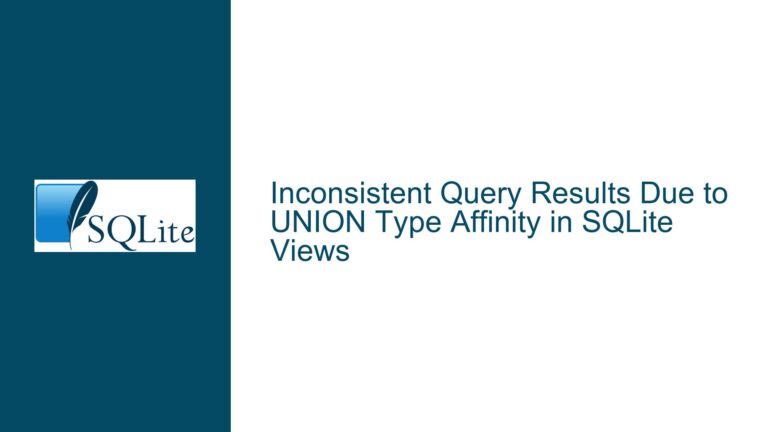Using DISTINCT with GROUP_CONCAT in SQLite: Troubleshooting and Solutions
Understanding the DISTINCT and GROUP_CONCAT Interaction in SQLite
The core issue revolves around the use of the DISTINCT keyword within the GROUP_CONCAT aggregate function in SQLite. Specifically, the problem arises when attempting to concatenate distinct values from a column while using a custom separator. The error message DISTINCT aggregates must have exactly one argument indicates a limitation in SQLite’s parsing logic, which treats the DISTINCT keyword as requiring a single argument, but the presence of a custom separator complicates this requirement.
The GROUP_CONCAT function in SQLite is designed to concatenate values from a group into a single string, optionally separated by a specified delimiter. When combined with DISTINCT, it should theoretically concatenate only unique values. However, SQLite’s parser interprets the comma separating the column name and the custom separator as part of a list of arguments for DISTINCT, leading to the error. This behavior is rooted in the way SQLite’s parser handles aggregate functions and the DISTINCT keyword, which is not as flexible as in some other SQL databases.
The Role of SQLite’s Parser in Handling DISTINCT and Custom Separators
SQLite’s parser is designed to handle aggregate functions with a specific syntax. When encountering DISTINCT, it expects a single argument immediately following the keyword. In the case of GROUP_CONCAT(DISTINCT column1, '|'), the parser sees DISTINCT column1, '|' and interprets this as a list of arguments for DISTINCT, rather than recognizing column1 as the argument for DISTINCT and '|' as the separator for GROUP_CONCAT. This parsing behavior is a fundamental limitation in SQLite’s current implementation, and it necessitates alternative approaches to achieve the desired functionality.
The error message DISTINCT aggregates must have exactly one argument is a direct result of this parsing limitation. It highlights the need for a workaround that avoids triggering this parsing issue while still achieving the goal of concatenating distinct values with a custom separator. This is particularly important in scenarios where the query is already complex, involving multiple joins and subqueries, and where simplicity and maintainability are key concerns.
Alternative Approaches to Achieve DISTINCT Concatenation with Custom Separators
Given the parsing limitation, several alternative approaches can be employed to achieve the desired result. One common method is to use a subquery to first select the distinct values and then apply GROUP_CONCAT to the result. This approach effectively separates the distinct selection from the concatenation process, avoiding the parsing issue. For example:
SELECT GROUP_CONCAT(column1, '|')
FROM (SELECT DISTINCT column1 FROM example_table GROUP BY column2);
This query first selects distinct values of column1 grouped by column2, and then concatenates these values using the specified separator. While this approach introduces a subquery, it maintains clarity and avoids the parsing error.
Another approach involves using the REPLACE function to manipulate the default comma separator used by GROUP_CONCAT. By concatenating a unique delimiter with each value and then replacing the default comma with the desired separator, you can achieve a similar result. For example:
SELECT REPLACE(GROUP_CONCAT(DISTINCT column1), ',', ' | ')
FROM example_table;
This query concatenates distinct values of column1 using the default comma separator and then replaces the commas with the desired separator. While this method avoids subqueries, it may not be as efficient, especially with large datasets, due to the additional string manipulation.
A more advanced technique involves concatenating a unique delimiter with each value and then trimming the result to remove any trailing delimiters. This approach ensures that the custom separator is correctly applied without interfering with the DISTINCT operation. For example:
SELECT RTRIM(REPLACE(GROUP_CONCAT(DISTINCT column1 || '@!'), '@!,', '|'), '@!')
FROM example_table;
In this query, each value is concatenated with a unique delimiter (@!), and the default comma separator is replaced with the desired separator (|). The RTRIM function is then used to remove any trailing delimiters, ensuring a clean result. This method provides a robust solution but requires careful handling of the delimiters to avoid unintended side effects.
Evaluating the Efficiency and Maintainability of Each Approach
When choosing between these approaches, it’s important to consider both efficiency and maintainability. The subquery method is straightforward and easy to understand, making it a good choice for maintainability. However, it may introduce additional overhead, especially with large datasets, due to the need to process the subquery before applying GROUP_CONCAT.
The REPLACE function method avoids subqueries but involves additional string manipulation, which can impact performance. This method is best suited for smaller datasets or scenarios where the additional processing overhead is acceptable. The advanced technique using unique delimiters and RTRIM offers a robust solution but requires careful implementation to avoid errors. This method is ideal for scenarios where precision and control over the output format are critical.
Ultimately, the choice of approach depends on the specific requirements of the query and the dataset. For maintainability and simplicity, the subquery method is often the best choice. For scenarios where performance is a concern and the dataset is manageable, the REPLACE function method may be more appropriate. The advanced technique should be reserved for cases where precise control over the output format is necessary.
Best Practices for Using DISTINCT with GROUP_CONCAT in SQLite
To ensure optimal performance and maintainability when using DISTINCT with GROUP_CONCAT in SQLite, consider the following best practices:
Use Subqueries for Clarity and Maintainability: When possible, use subqueries to separate the distinct selection from the concatenation process. This approach is easy to understand and maintain, making it ideal for complex queries.
Minimize String Manipulation: Avoid unnecessary string manipulation, such as using
REPLACEorRTRIM, unless absolutely necessary. These operations can introduce additional overhead and complicate the query.Test with Real Data: Always test your queries with real data to ensure they perform as expected. This is especially important when using advanced techniques or working with large datasets.
Document Your Queries: Clearly document any workarounds or advanced techniques used in your queries. This will help others understand and maintain the code in the future.
Consider Database-Specific Limitations: Be aware of the limitations and quirks of the database you are using. In the case of SQLite, understanding the parsing behavior of
DISTINCTandGROUP_CONCATis crucial for writing effective queries.
By following these best practices, you can ensure that your queries are both efficient and maintainable, even when dealing with the limitations of SQLite’s parser.
Conclusion
The interaction between DISTINCT and GROUP_CONCAT in SQLite presents a unique challenge due to the parser’s handling of the DISTINCT keyword. While the error DISTINCT aggregates must have exactly one argument can be frustrating, several alternative approaches can be used to achieve the desired result. By understanding the underlying parsing behavior and evaluating the efficiency and maintainability of each approach, you can choose the best solution for your specific scenario. Whether using subqueries, the REPLACE function, or advanced techniques with unique delimiters, the key is to balance performance, clarity, and precision in your queries.






